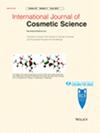Internal structural changes in age-related curved hair due to cyclical extension: An IR spectroscopy study
Abstract
Objective
This study aimed to identify structural changes in age-related curved hair (referred to as “YUGAMI” hair in Japanese) induced by cyclical extension using infrared (IR) spectroscopy coupled with chemometrics, such as multivariate curve resolution (MCR) and two-dimensional correlation spectroscopy (2DCOS).
Methods
The hair fibres were stretched at a strain level of 0.3-N, and this operation was counted as one cycle and was repeated 500 cycles. Every 25 cycles, IR spectra were obtained using an attenuated total reflection IR (ATR–IR) microscope. The spectra were analysed by MCR to investigate the structural changes of keratin protein inside of the hair. 2DCOS was conducted to investigate the genesis pathway of SO3H in the 1000–1150 cm−1 range and the change in the secondary structure of keratin protein of hair in the 1600–1700 cm−1 range.
Results
For age-related curved hair, 0.3-N strain levels increased the CH2 and C=O signals after 125 cycles and the SO3H signal after 225 cycles, but no architectural modifications were observed in straight hair. Two results were obtained from 2DCOS. One was cyclical extension increased the S–SO3H signal, followed by SO3H signal. The other in the 1600–1700 cm−1 range indicated an increase in the secondary structural motif and β-structure after the formation of SO3H.
Conclusion
This study shows that the process of internal transformations can be split into three steps in age-related curved hair caused by cyclical extension. The first step is the surface transfer of internal lipids, and the second step is two distinct patterns of disulfide bond cleavage: C–S and S–S fission. The final step is further transformation of the unravelled α-helices into β-structures which occurs above roughly 225 stretched. Our findings can be an effective factor in care the increase of curvature by cyclical extension such as everyday grooming.


 求助内容:
求助内容: 应助结果提醒方式:
应助结果提醒方式:


